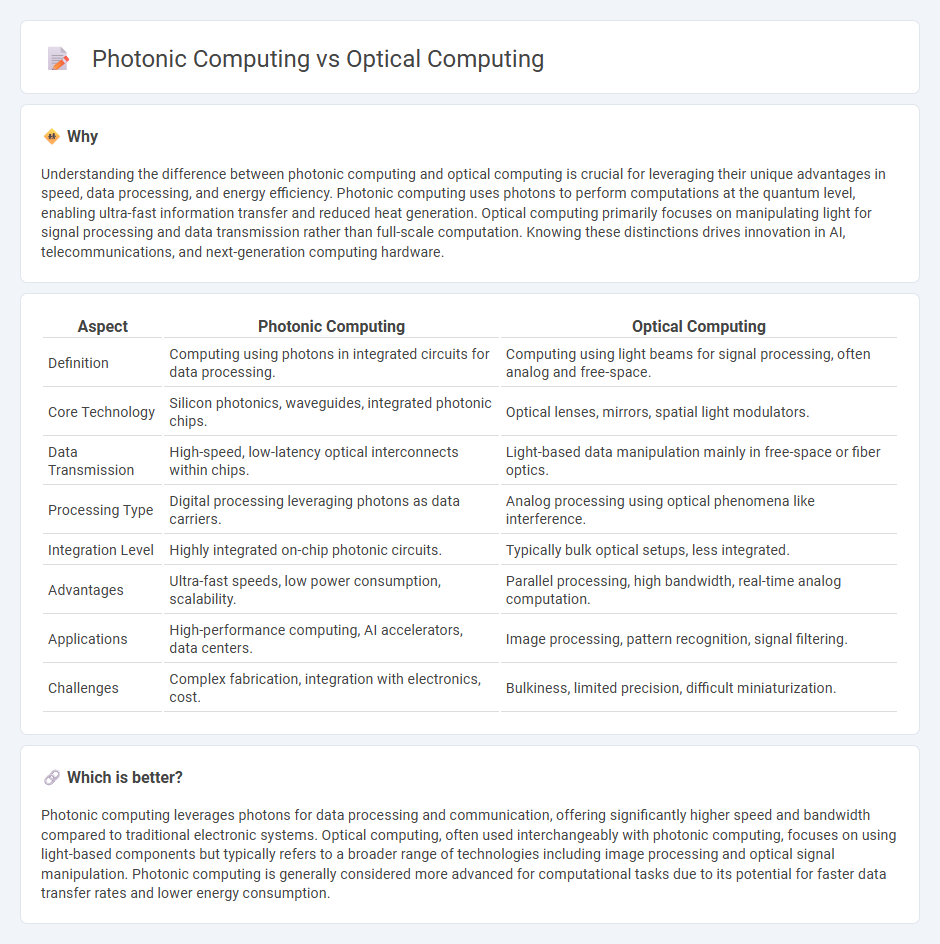
Photonic computing harnesses photons generated by lasers or diodes to process data at the speed of light, enabling ultra-fast computation with minimal heat dissipation. Optical computing relies on the manipulation of light waves through components like lenses and mirrors to perform calculations, often focusing on signal processing and data transmission. Explore the distinctions between these cutting-edge technologies to understand their impact on future computing architectures.
Why it is important
Understanding the difference between photonic computing and optical computing is crucial for leveraging their unique advantages in speed, data processing, and energy efficiency. Photonic computing uses photons to perform computations at the quantum level, enabling ultra-fast information transfer and reduced heat generation. Optical computing primarily focuses on manipulating light for signal processing and data transmission rather than full-scale computation. Knowing these distinctions drives innovation in AI, telecommunications, and next-generation computing hardware.
Comparison Table
| Aspect | Photonic Computing | Optical Computing |
|---|---|---|
| Definition | Computing using photons in integrated circuits for data processing. | Computing using light beams for signal processing, often analog and free-space. |
| Core Technology | Silicon photonics, waveguides, integrated photonic chips. | Optical lenses, mirrors, spatial light modulators. |
| Data Transmission | High-speed, low-latency optical interconnects within chips. | Light-based data manipulation mainly in free-space or fiber optics. |
| Processing Type | Digital processing leveraging photons as data carriers. | Analog processing using optical phenomena like interference. |
| Integration Level | Highly integrated on-chip photonic circuits. | Typically bulk optical setups, less integrated. |
| Advantages | Ultra-fast speeds, low power consumption, scalability. | Parallel processing, high bandwidth, real-time analog computation. |
| Applications | High-performance computing, AI accelerators, data centers. | Image processing, pattern recognition, signal filtering. |
| Challenges | Complex fabrication, integration with electronics, cost. | Bulkiness, limited precision, difficult miniaturization. |
Which is better?
Photonic computing leverages photons for data processing and communication, offering significantly higher speed and bandwidth compared to traditional electronic systems. Optical computing, often used interchangeably with photonic computing, focuses on using light-based components but typically refers to a broader range of technologies including image processing and optical signal manipulation. Photonic computing is generally considered more advanced for computational tasks due to its potential for faster data transfer rates and lower energy consumption.
Connection
Photonic computing and optical computing both leverage light-based technologies to process information, using photons instead of electrons to achieve faster data transmission and reduced energy consumption. These computing methods rely on optical components such as lasers, waveguides, and photodetectors to perform calculations and signal processing at the speed of light. Their integration aims to overcome the limitations of traditional electronic processors by enabling ultra-high bandwidth and parallelism in data-intensive applications.
Key Terms
Light-Based Logic
Optical computing and photonic computing both harness light to perform calculations, but optical computing primarily uses light beams for data transmission and processing in logic gates, while photonic computing leverages photons in more complex architectures for higher-speed, lower-energy operations. Light-based logic in optical computing focuses on manipulating light intensity and interference patterns to execute logical operations, whereas photonic computing employs quantum properties of photons for advanced logic functions and parallel processing. Explore the intricacies of light-based logic to understand how these technologies are revolutionizing computational speed and efficiency.
Wavelength Multiplexing
Wavelength division multiplexing (WDM) is a critical technology in photonic computing, enabling multiple data channels to be transmitted simultaneously through a single optical fiber by using different wavelengths of light. Optical computing, while leveraging light for processing, typically focuses on single-wavelength or less complex multiplexing methods, limiting bandwidth compared to photonic systems heavily reliant on WDM. Explore the advanced capabilities of wavelength multiplexing in photonic computing to understand its impact on speed and data throughput.
Photonic Integrated Circuits
Photonic Integrated Circuits (PICs) play a crucial role in both optical and photonic computing by enabling the integration of multiple photonic functions on a single chip, significantly enhancing data processing speeds and energy efficiency compared to electronic counterparts. Optical computing generally relies on bulk optical components to manipulate light for computation, while photonic computing leverages PICs to miniaturize and scale photonic operations for faster parallel processing and lower latency. Explore the latest advances in Photonic Integrated Circuits to understand their transformative impact on the future of computing technologies.
Source and External Links
Optical computing - Wikipedia - Optical computing uses light waves for data processing, storage, and communication, offering higher bandwidth than electronic computing, and commonly integrates optical components with traditional electronics to form hybrid systems, though full all-optical computers can eliminate energy-consuming optical-electrical conversions.
Optical Computing: Status and Perspectives - PMC - PubMed Central - Optical technology enables much faster, more efficient computation with potential speeds up to 100,000 times faster than current computers by leveraging massive parallelism and parallel switching at nanosecond or sub-picosecond rates.
Optical computing: the power of light - TechHQ - Optical computers perform digital computations using photons, offering advantages like high speed, parallelism, immunity to electromagnetic interference, and low transmission loss but face challenges including complexity, difficulty in developing photonic crystals, and bulky current prototypes.
 dowidth.com
dowidth.com